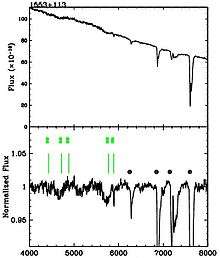BL Lac object


A BL Lacertae object or BL Lac object is a type of active galaxy with an active galactic nucleus (AGN), named after its prototype, BL Lacertae. In contrast to other types of active galactic nuclei, BL Lacs are characterized by rapid and large-amplitude flux variability and significant optical polarization. Because of these properties, the prototype of the class (BL Lac) was originally thought to be a variable star. When compared to the more luminous active nuclei (quasars) with strong emission lines, BL Lac objects have spectra dominated by a featureless non-thermal continuum.[1][2]
In the unified scheme of radio-loud active galactic nuclei, the observed nuclear phenomenology of BL Lacs is interpreted as being due to the effects of the relativistic jet that is closely aligned to the line of sight of the observer. BL Lacs are thought to be intrinsically identical to low-power radio galaxies. These active nuclei are hosted in massive spheroidal galaxies. From the point of AGN classification, BL Lacs are a blazar subtype. All known BL Lacs are associated with core dominated radio sources, many of them exhibiting superluminal motion.
Some examples of BL Lac objects are BL Lacertae itself, OJ 287, AP Librae, PKS 2155-304, PKS 0521-365, Markarian 421, 3C 371, W Com, ON 325 and Markarian 501.
Host galaxies
Soon after the discovery of this unusual class of objects it was noted that the sources were surrounded by a faint nebulosity. In the late 1970sthe use of modern detectors (such as CCD) allowed observers to probe with better accuracy the nature of the nebulosity. First images of the BL Lac PKS 0548-322 by M. Disney in 1974 in various filters found it to be composed by a giant elliptical galaxy with a bright nucleus.
About 10 years later, at the second conference entirely dedicated to BL Lac objects in Como a report by M-H. Ulrich listed about 15 objects for which their host galaxy was measured and then compared with the properties of bright radio galaxies in order to test the consistency of the hypothesis that BL Lacs are indeed the parent population of FR -I radio galaxies with the jet pointing closely to the observer direction. With the caveat of the exiguity of the sample and the non homogeneous used dataset it was argued that BL Lac host population is very similar to that of B2 radiogalaxies.
History
John L. Schmitt first noticed the peculiar nature of BL Lac in 1968 when he matched it with a radio object, VRO 42.22.01.[3]
Within a year others observed that the radio flux varied, and that light was polarized. Strittmatter proposed the class of object in 1972 and added four objects. By 1976 there were 30 known objects.[1]
See also
References
- 1 2 Stein, W A; O'Dell, S L; Strittmatter, P A (September 1976). "The BL Lacertae Objects" (PDF). Annual Review of Astronomy and Astrophysics. Annual Reviews. 14: 173–195. Bibcode:1976ARA&A..14..173S. doi:10.1146/annurev.aa.14.090176.001133.
- ↑ Ajello, M.; Romani, R. W.; Gasparrini, D.; Shaw, M. S.; Bolmer, J.; Cotter, G.; Finke, J.; Greiner, J.; Healey, S. E. (2014-01-01). "The Cosmic Evolution of Fermi BL Lacertae Objects". The Astrophysical Journal. 780 (1): 73. arXiv:1310.0006
 . Bibcode:2014ApJ...780...73A. doi:10.1088/0004-637X/780/1/73.
. Bibcode:2014ApJ...780...73A. doi:10.1088/0004-637X/780/1/73. - ↑ Schmitt, John L. (May 1968). "BL Lac identified as a Radio Source". Nature. 218 (5142): 663. Bibcode:1968Natur.218..663S. doi:10.1038/218663a0.
Sources
- Marscher, A P; et al. (24 April 2008). "The inner jet of an active galactic nucleus as revealed by a radio-to-gamma-ray outburst". Nature. 452 (7190): 966–969. Bibcode:2008Natur.452..966M. doi:10.1038/nature06895. PMID 18432239.
- Padovani, Paolo; Giommi, Paolo (15 December 1995). "A Sample-Oriented Catalogue of BL Lacertae Objects". Monthly Notices of the Royal Astronomical Society. 277 (4): 1477–1490. arXiv:astro-ph/9511065v1
 . Bibcode:1995MNRAS.277.1477P. doi:10.1093/mnras/277.4.1477.
. Bibcode:1995MNRAS.277.1477P. doi:10.1093/mnras/277.4.1477.
External links
- ZBLLAC - A spectroscopic library of BL Lac objects